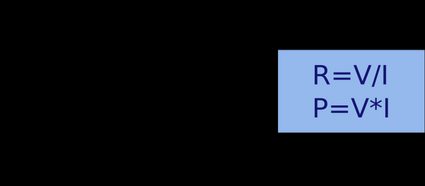Ohm's Law Power Calculator
If you're searching for how to calculate power from Ohm's Law, you're in the right place. With this tool, you can determine this quantity by inputting two of the other three variables (voltage, current, and resistance).
Don't you know what we're talking about? Don't worry. In the rest of the article, we explain the formula of Ohm's law and the power equations that arise from it.
Ohm's law and power equation
Essentially, Ohm's law states that the current and voltage difference between two points on a conductor are directly proportional:
I = V/R
where:
- I — Current, in amperes (A);
- V — Voltage difference, in volts (V); and
- R — Electrical resistance, in ohms (Ω).
As mentioned before, I and V are proportional, and the inverse of the resistance (I/R) is the constant of proportionality. We discuss electrical resistance and its determining factors in the wire resistance calculator.
It's important to mention that Ohm's law only applies to resistive circuits, which are those containing only resistive elements (no capacitances or inductances).
Electric power
Current refers to how many charged particles (electrons, usually) pass over a conductor. This movement represents electrical energy.
On the other side, as we explain in the work and power calculator, power is the rate at which work is done. Regarding electrical energy, power indicates how fast the charged particles use their energy to do work, which consists of passing through an electric potential (voltage) difference. Mathematically, electric power (P), in watts (W), is the product of voltage difference and current:
P = V × I
If the circuit is resistive, we can use Ohm's law and express electric power in these other ways:
P = R × I² = V²/R
Other tools like this Ohm's law power calculator
FAQs
How many watts is 30 amp at 120 volts?
3600 watts. To know how many watts is 30 amp at 120 volts, we can use the formula for electric power, which says power equals voltage times current:
P = V × I = 120 V × 30 A = 3600 W
where:
- P — Electric power;
- V — Voltage; and
- I — Current.
How do I calculate power from Ohm's law?
We can calculate power (P) with Ohm's law in various ways:
- Multiplying the voltage by the current: P = V × I (the most common formula for Ohm's law power calculation).
- Multiplying the resistance by the square of the current: P = R × I².
- Dividing the square of the voltage by the resistance: P = V²/R.
What is the resistance of an 8 AWG copper wire?
In different units, the resistance of an 8 AWG copper wire is:
- 0.0006121 ohms per foot (Ω/ft);
- 0.6121 ohms per every 1000 feet (Ω/1000 ft);
- 0.0020082 ohms per every meter (Ω/m); and
- 2.0082 ohms per every 1000 meters (Ω/km).
